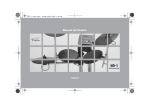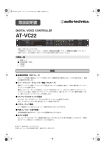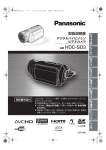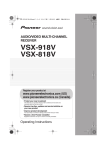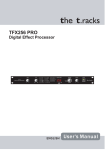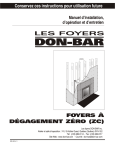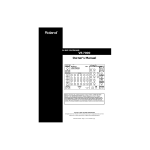Download Roland PM-01 Owner`s manual
Transcript
HD-1_r_e.book 1 ページ 2007年3月28日 水曜日 午後6時58分 HD-1_r_e.book 2 ページ 2007年3月28日 水曜日 午後6時58分 Options PM-01 Personal Drum Monitor The perfect home amplifier for the HD-1 V-Drums Lite. 2 DAP-1 V-Drums Accessory Package Essential Accessories for V-Drummers • Drum Throne • Drum Sticks • Inner Earphones • Stereo Mini-Cable TDM-1 V-Drums Mat Secure-Performance Mat for HD-1 HD-1_r_e.book 3 ページ 2007年3月28日 水曜日 午後6時58分 Introduction Drumming is for everybody and the Roland HD-1 V-Drums Lite is the best way to add rhythm and music to your life! The Roland HD-1 V-Drums Lite is for anyone who wants to enjoy playing drums. It is portable, durable and loaded with professional sounds. It is perfect for home, office, project studio or live performance, everywhere you want to play. Whether you are just starting out or have experience playing the drums, the HD-1 is a great way to have fun playing and get involved in music. 3 HD-1_r_e.book 4 ページ 2007年3月28日 水曜日 午後6時58分 Contents 201a Before using this unit, carefully read the sections entitled: “USING THE UNIT SAFELY” and “IMPORTANT NOTES” (Set-up Guide). These sections provide important information concerning the proper operation of the unit. Additionally, in order to feel assured that you have gained a good grasp of every feature provided by your new unit, Owner’s manual should be read in its entirety. The manual should be saved and kept on hand as a convenient reference. Options............................................ 2 Replacing a Pad ............................. 17 Replacing the Snare Head ......................................... 17 Detaching/Mounting a Tom Pad ................................ 18 Detaching a Tom Pad .................................. 18 Mounting a Tom Pad ................................... 18 Introduction ..................................... 3 Features........................................... 5 Drum Set Elements ....................................................... 6 Panel and Parts Descriptions ........................................ 8 Troubleshooting ............................. 19 Getting Ready to Perform .............. 10 Drum Kit Sound List........................ 20 Getting Connected ..................................................... 10 Turning On the Power................................................ 11 Adjusting the Head Tension on the Snare.................... 12 About MIDI .................................... 21 Conversion for Left-Handed use ..... 22 Playing the Kit ............................... 13 Holding the Sticks ........................................ 13 Selecting a Kit ............................................. 14 Listening to Patterns ..................................... 14 Pad Sensitivity ........................................................... 15 Metronome Operations .............................................. 16 4 Specifications ................................. 23 Notation ........................................ 24 202 Copyright © 2007 ROLAND CORPORATION All rights reserved. No part of this publication may be reproduced in any form without the written permission of ROLAND CORPORATION. HD-1_r_e.book 5 ページ 2007年3月28日 水曜日 午後6時58分 Features Sounds 70 high quality Drum, Percussion and special effects sounds are ready to play with the 10 different drum kits. It’s Quiet! Specially developed kick and hi-hat pedals are mounted on the support pipes, minimizing direct vibration to the floor. Lightweight and Compact Play with External Audio Sources The Mix in jack allows one to connect external audio sources, ideal for playing along with CDs, MP3 players, etc. Outputs 2 pairs of headphones can be used by plugging them into the headphone and output jacks at the same time. For details on drum kits, refer to “About the Drum Kits” (p. 15). The HD-1 requires very little space, and by simply folding in the pad support pipes, it can be transported easily. Simple to Use Easy operation with just 2 knobs and 7 buttons. Built-in Metronome The built-in metronome is a valuable practice tool. 5 HD-1_r_e.book 6 ページ 2007年3月28日 水曜日 午後6時58分 Drum Set Elements Here are some basic terms related to drum sets. Acoustic Drum Kick (Bass Drum) Played with a kick pedal, it’s the largest drum in the kit. fig.DrumSet-e Ride Crash Crash Tom Tom Snare Drum Ride The snare drum is the main “voice” of a drum kit. Hi-Hat An acoustic hi-hat uses 2 cymbals mounted on a hi-hat stand. * The HD-1 uses a single pad. Floor Tom Hi-Hat Hi-Hat Pedal Pressing the hi-hat pedal opens and closes it. Snare Tom Toms These are usually mounted on the bass drum, or separate stands. Hi-Hat Pedal 6 Kick Pedal HD-1_r_e.book 7 ページ 2007年3月28日 水曜日 午後6時58分 Floor Tom (Tom 3) Sometimes called a bass tom, it either stands on it’s own legs or is mounted on a stand. Ride Cymbal Usually mounted on the right side of the kit, the ride cymbal is principle elements in keeping time. HD-1 fig.PadDescription-e Tom 1 (T1) Tom 2 (T2) Crash (CR) Ride (RD) Crash Cymbal Smaller than the ride, the crash cymbal is mainly used for accents. * The indications in parentheses ( ) show the names used on the HD-1. Hi-Hat (HH) Snare (SNR) Hi-Hat Pedal (HHC) Tom 3 (T3) Kick Pedal (KIK) Letters and numbers in parentheses ( ) relate to the cable labeling. 7 HD-1_r_e.book 8 ページ 2007年3月28日 水曜日 午後6時58分 Panel and Parts Descriptions fig.PanelDescription fig.PanelDescription Left Side 1 Right Side 8 9 6 10 11 2 3 4 7 5 1. [VOLUME] Knob Adjusts the sound level (p. 11). 2. [TEMPO] Knob For setting the speed of the metronome or patterns (p. 15, p. 16). 3. [ ] Button For starting and stopping the metronome (p. 16). 4. [ ]–[ ] Buttons For selecting drum kits (p. 14). 5. [ ] Button For selecting a kit variation (p. 14). 8 6. POWER Switch Turns the power on or off (p. 11). 7. AC Adaptor Jack For connecting the power supply (p. 10). 8. MIDI OUT Connector Use when playing sounds on an external sound module or for recording to a sequencer. HD-1_r_e.book 9 ページ 2007年3月28日 水曜日 午後6時58分 9. MIX IN Jack fig.PanelDescription For connecting an external audio source (CD or MP3 player). Sound input here will also be heard through the main and headphone outputs. The balance between those sounds and the HD-1 is determined by the level of the external audio player. 12 10. OUTPUT Jack For connecting an optional amplifier (PM-01) or headphones. 11. Headphone Jack 13 For connecting headphones (when headphones are connected, the OUTPUT jack will still be active). 12. Cord Hook fig.cordhook For securing the power adaptor cord. This helps prevent accidental power outage and relieves undue stress to the AC adaptor jack. 13. Trigger Cable Connector This connects the pads to the sound module. 9 HD-1_r_e.book 10 ページ 2007年3月28日 水曜日 午後6時58分 Getting Ready to Perform For details on assembling the stand, refer to the separate leaflet “Set-Up Guide.” Getting Connected As a security measure to prevent damage to speakers or other devices, be sure the power is off on the HD-1 before making any connections. fig.setsuzoku-e Personal audio player etc. (when you want to play the HD-1 along with music) Stereo mini plug Place the AC adaptor so that its lamp light is on the top side. (it lights up when connected to an AC outlet) Audio Cable Stereo mini plug Lamp AC Adaptor Speaker etc. Headphones Anchor the power cord using the cord hook, as shown in the illustration. 2 headphones can be used by using the OUTPUT jack and the headphone jack at the same time. Perfect for drum lessons! 10 HD-1_r_e.book 11 ページ 2007年3月28日 水曜日 午後6時58分 Turning On the Power Once connections have been made (p. 10), turn on the power to all connected devices in the order as specified below. Doing otherwise raises the risk of damage or malfunction to the connected devices. fig.powerOn * As there is a built-in protection circuit, it takes a few seconds before the HD-1 is ready to play. If You Don’t Hear Sound Please check the following points. 1, 4 2 If using an amp/audio system • Power is on? • Volume setting is correct? • All input/output connections are correct? • Faulty cable? If using headphones • Correctly connected to the headphones or OUTPUT jack? 1. Make sure that the HD-1s [VOLUME] knob, and that of any connected amp, is set to the minimum level. 2. Turn on the HD-1. 3. Turn on the power of the connected amp/speaker. 4. Then raise the volume of both to get the sound level required. 11 HD-1_r_e.book 12 ページ 2007年3月28日 水曜日 午後6時58分 Adjusting the Head Tension on the Snare Before playing the snare pad, you must tighten the head. If it is too loose, problems such as faulty triggering may occur. • Adjusting the tension of the snare head will not change the sound as it would on an acoustic drum. • Head tuning should be checked on a regular basis, as constant playing may slacken the tension. • Synthetic rubber is used on the pads and cymbals. Should the smell of rubber bother you, make sure there is good air circulation in the room. NEVER place the HD-1 near a heater or source of high temperature. 1. Use the included drum key, and tighten each tuning bolt slightly, in the order shown in the diagram. This guarantees even tension and a correct head response. fig.Adjust-e Loosen Tighten 6 1 4 3 2 5 2. While hitting the pad, make final adjustments to have the best feel and response from the head. 12 The drum key can be conveniently mounted on the hook of the arm pipe. HD-1_r_e.book 13 ページ 2007年3月28日 水曜日 午後6時58分 Playing the Kit Holding the Sticks The most common way to hold the sticks is called the “matched grip” as shown in the photos below. fig.holdingStick (Left hand) (Right hand) Playing the Cymbal Pads Play ONLY on the rubber surface. Playing on the plastic part will produce sound, but you can damage the pad. fig.SymbalShot-e Pad Face 13 HD-1_r_e.book 14 ページ 2007年3月28日 水曜日 午後6時58分 Selecting a Kit Listening to Patterns A drum kit consists of sounds assigned to each pad. In some cases, the sound will change depending upon your playing dynamics. Before playing back a pattern, lower the volume of the HD-1. The volume of these patterns may be louder than when you play the kit normally, and you do not want to risk damage to your ears or connected equipment. Also, when patterns are playing, hitting the pads will not produce sound. 1. Press and hold one of the [ seconds. ]–[ ] buttons for a few A pattern using this current kit will play. 1 1. Buttons from [ ] through [ 2 ] If you press the [ ] button, the pattern for that variation kit will play. You can change the tempo of the pattern by adjusting the [TEMPO] knob. Pressing these buttons will call up different kits. 2. Variation [ ] When you press this button, you can access the variation kits. Example: Play the kit [ Press [ 14 ] (Accorstic). ] and you play the variation kit (Jazz). Each pattern will play at it’s default tempo (set at the factory). To change the tempo of the pattern, adjust the TEMPO knob AFTER playback has started. 2. Playback will stop if you press any one of the kit buttons during playback. HD-1_r_e.book 15 ページ 2007年3月28日 水曜日 午後6時58分 About the Drum Kits Here is an explanation about the sounds used in each kit. Button Normal Kit Variation Kit Pad Sensitivity The HD-1 can be adjusted to accommodate any dynamic level of playing, allowing even children with a very light touch, to get a good response from the drum kit. 1 Acoustic This is a basic acoustic type of drum set. Jazz Jazz kit featuring a sizzle ride cymbal. 2 Power A rock kit featuring a deep reverb sound, similar to a large concert hall. Double Bass A rock kit where the hi-hat pedal becomes a 2nd bass drum. 1. Hold down [ starts to blink. 3 Drums & Percussion Features a combination of drum and percussion sounds. World Features world percussion sounds. 2. Keep pressing the [ ] button, and then press a button from [ ] to [ ] to change the sensitivity. 4 Electronic Features sounds from a Roland TR-808. Dance Perfect for club, house and dance music. Voices Features voices, human beat box and chorus sounds. Droid This is a kit featuring special effects sounds. 5 More details about the individual sounds in each kit can be found in the “Drum Kit Sound List” (p. 20). To adjust the pad/pedals sensitivity do the following: Note: This is a “global” function, meaning the sensitivity of all pads with change together. ] for a few seconds until the button (the factory setting is 3) Button Sensitivity 5 Loud volume can produced playing very lightly 4 Loud volume can produced playing lightly 3 Normal (factory setting) 2 Loud volume requires fairly strong playing 1 Loud volume requires VERY strong playing 3. When you’ve finished making the setting, release [ ]. 15 HD-1_r_e.book 16 ページ 2007年3月28日 水曜日 午後6時58分 Metronome Operations The HD-1’s built-in metronome is a valuable practice aid. Adjusting the Metronome Volume 1. While the metronome is playing, press and continue to hold down the [ ] button. 2. While pressing [ ], touch a button from [ ] through [ ] to adjust the volume. Three levels are provided, “soft -medium-loud.” 3. When satisfied, release [ 2 1. Press [ [ 1 ]. ] lights up and the metronome starts. 2. Turn the [TEMPO] knob to adjust the tempo. (Range: 40–220 BPM) ]. Changing the Metronome Sound 1. While the metronome is playing, press and continue to hold down the [ ] button. 2. While pressing [ ], touch [ ], [ button to choose the desired sound. ] or the [ ] The choices are: 4: Click 5: Cowbell 6: Maraca 3. When satisfied, release [ ]. The above settings are memorised by the HD-1, even if the power is turned off. 16 HD-1_r_e.book 17 ページ 2007年3月28日 水曜日 午後6時58分 Replacing a Pad Replacing the Snare Head If it’s necessary to replace the head on the snare, follow these instructions: 1. Remove all the tuning bolts. Optional replacement head: MH-8 Mesh Head 2. Remove the hoop. fig.replace-snare-e Loosen Tighten 3. Take off the old head. Drum Key 4. Place the new head on the shell. Tuning Bolt 5. Mount the hoop. 6. Re-attatch the tuning bolds and adjust the tension (p. 12). Hoop Head Sensor Hoop’s Rubber Portion Shell The sensor and cushion under the head are very sensitive. Put no pressure on these parts as it may disrupt the proper functioning of the pad. • Do not firmly tighten a single tuning bolt by itself. Doing so will make it impossible to tension the head evenly, and will cause malfunctions. • Due to the nature of the materials used in the sensor, changes in room temperature may affect the sensitivity of the sensor. • The rubber portion of the striking surface is treated with a preservative to maintain its performance. With the passage of time, this preservative may appear on the surface as a white stain, or reveal how the pads were struck during product testing. This does not affect the performance or functionality of the product, and you may continue using it with confidence. 17 HD-1_r_e.book 18 ページ 2007年3月28日 水曜日 午後6時58分 Detaching/Mounting a Tom Pad Please remember that the pads designed for the HD-1 will not fit on any other brand of stand. fig.replace-tam4-j 5. Remove the tom pad from the pipe. Detaching a Tom Pad 1. Unplug the tom and cymbal cables. fig.replace-tam3-j Mounting a Tom Pad 2. Use a drum key to remove bolt securing the cymbal rod from the pipe. This is basically a reverse operation of the detaching process. But when re-fitting the pads to the pipes, be careful to align the grooves in the pipe with the triangular protrusions of the pad. The pads can be fitted to three pitch(angle) positions. fig.replace-tam1-j 3. Remove the plastic end-cap from the pipe. * Do not insert your finger into the pipe while the cap is removed. fig.replace-tam2-j 4. Use a drum key to loosen the bolt securing the pad to the pipe. 18 Tom1, Tom2 end-cap fig.tom1-2 Tom3 HD-1_r_e.book 19 ページ 2007年3月28日 水曜日 午後6時58分 Troubleshooting If you suspect a malfunction, please read this page first. Power does not turn on AC adaptor is connected properly? (p. 10) No sound • Check the volume knob. • Are all pad cables connected correctly? If using an amp/audio system • Volume settings and input/output connections are correct? • If using headphones, are they correctly connected to the headphones or OUTPUT jack? No Sound from external audio source connected to the MIX IN jack • If you are using a connection cable that contains a resistor, this will reduce the volume. Use a cable with no resistor. • Faulty cable? If so, replace it. • Volume setting is correct on the connected audio source? • Amp or audio system settings and connections are correct? Sound is distorted in headphones • Adjust the volume. • Headphones are working correctly? To check them, connect them to another audio source to verify. Output sound is distorted Sound is too soft/loud when playing Check the sensitivity adjustments. Lower the volume on the HD-1. Or, if the connected amp has an input level adjustment, adjust accordingly. Double triggering occurs • • • • Check the bolts that secure the tom pads to the pipe. Be sure no cables are touching the pads. Use cable ties to secure any excess slack. Verify that the cymbal pad movement does not pull on the cable. 19 HD-1_r_e.book 20 ページ 2007年3月28日 水曜日 午後6時58分 Drum Kit Sound List Tom 2 Tom 3 Hi-Hat Normal Acoustic Wood Kick Bright Snare Wood Tom Hi Wood Tom Mid Wood Tom Low Heavy Hi-Hat Pop Ride Fast Crash Variation Jazz Jazz Kick Jazz Snare Jazz Tom Hi Cross Stick Jazz Tom Low Jazz Hi-Hat Sizzle Ride Fast “Tip” Crash Normal Power Heavy Kick Rock Snare Power Tom Hi Power Tom Mid Power Tom Low Dark Hi-Hat Medium Ride Thin Crash Variation Double Bass Heavy Kick Rock Snare Power Tom Hi Rock Cowbell Power Tom Low Heavy Kick/ Open Hi-Hat China/Ride Thin Crash Normal Drums & Percussion Jazz Kick Jazz Snare Timbales Conga Djembe Heavy Hi-Hat Pop Ride Splash Variation World Cajon Stomp Cajon Snare Qujada/ Caxixi Berimbau Pot Drum Pandeiro Crasher Agogo Crotale Normal Electronic TR-808 Kick TR-808 Snare Hex Tom1 Hex Tom2 Hex Tom3 House Hi-Hat TR-808 Cowbell DR-110 Crash Variation Dance House Kick House Snare House Clap Scratch Super Low House Hi-Hat Reverse Ride Space Crash Normal Voices Voice Kick Voice Snare Voice-Bang Voice-Dooit Voice-Boom Voice Hi-Hat Voice-Tun VoiceHarmony Variation Droid Boing Kick Industrial Snare Ratchet Tom Droid Voice Jet Tom Droid Hi-Hat Ba-Da-Bit Chemical Crash No. 20 Kit Name Kick Snare Tom 1 Ride Crash HD-1_r_e.book 21 ページ 2007年3月28日 水曜日 午後6時58分 About MIDI By connecting an external sound module to the HD-1’s MIDI OUT connector you can play sounds on that external module. If you connect the MIDI OUT to a sequencer, you can record your performance. MIDI transmit channel Pad Pad Note Number Kick Pedal 36 Crash 49 Snare 38 Ride 51 Tom1 48 Hi-Hat (Open) 46 Tom2 45 Hi-Hat (Closed) 42 Tom3 43 Foot Close 44 Program Change 1 2 3 10 x x x Mode Default Messages Altered Mode 3 x ************** x x True Voice 36, 38, 42–46, 48 49, 51 x ************** Velocity Note ON Note OFF O 99H, V=1–127 x 89H, V=64 x x After Touch Key’s Ch’s x x x x x x O x Foot Control*1 O (0...9) ************** x Cannot be changed Prog. 1–10 x x x x x x x x x x Prog Change Drum Kit PC Drum Kit PC 1 Normal 4 Variation 6 Variation 9 Normal 2 Normal 5 Variation 7 Normal 3 Variation 8 4 5 Variation Note Number : Control Change Normal Remarks Default Changed Pitch Bend The following program change numbers are transmitted when you switch drum kits. Recognized Basic Channel 10 Note Number Date : Mar. 1, 2007 Version : 1.00 Transmitted Function... Position data is transmitted using control change number 4 (foot controller). Hi-Hat Pedal Note number produced when you strike a pad MIDI Implementation Chart ELECTRONIC DRUM Model HD-1 4 : True Number System Exclusive : Song Pos System : Song Sel Common : Tune Cannot be changed Cannot be changed System Real Time : Clock : Commands x x Aux Message : All sound off : Reset all controllers : Local Control : All Notes OFF : Active Sense : Reset x x x x x x x x O x x x *1 Transmits the position of the hi-hat pedal. 10 Notes Mode 1 : OMNI ON, POLY Mode 3 : OMNI OFF, POLY Mode 2 : OMNI ON, MONO Mode 4 : OMNI OFF, MONO O : Yes X : No 21 HD-1_r_e.book 22 ページ 2007年3月28日 水曜日 午後6時58分 Conversion for Left-Handed Use If you are left handed, it is possible to configure the HD-1 for you. Follow these instructions: * You will need two 50 cm extension cables. 1. Remove both the crash and ride cables from the cymbal rod, then connect an extension cable to each of them. Next, switch the connections for these two cables. 2. Switch the cable connections to the Tom1 and Tom2 pads. 3. Remove and switch the positions and connections of the Tom3 and Hi-Hat pads. * Pay attention to the angle when attaching tom 3 (p. 18). 4. Switch the cable connections to the KICK and Hi-Hat CONTROL pedals. (refer to the set-up instruction sheet if necessary) 22 HD-1_r_e.book 23 ページ 2007年3月28日 水曜日 午後6時58分 Specifications HD-1 V-Drums Lite ● Power Supply: ● Kit Configuration ● Current Draw: ● Drum Kits: ● Dimensions: Kick Pedal, Snare, Hi-Hat, Hi-Hat Pedal, Tom x 3, Crash, Ride 10 ● Patterns: 10 ● Controls: Drum Kit button x 5 Variation button Metronome button Volume knob Tempo knob ● Metronome: Tempo (40--220) Sounds (3 types) Volume (3 levels) ● Connectors: Output jack (Stereo miniature phone type) (*1) Headphone jack (Stereo miniature phone type) Mix In jack (Stereo miniature phone type) MIDI Out connector (5-pin DIN type) Trigger Cable connector (DB-25 type) Output Jack can be connected with headphones. (*1): Output Jack can be connected with headphones. DC 9 V (AC Adaptor) 300 mA 850 (W) x 560 (D) x 1170 (H) mm 33-1/2 (W) x 22-1/16 (D) x 46-1/16 (H) inches ● Weight: 15 kg / 33 lbs 2 oz (Excluding AC Adaptor) ● Accessories: Owner’s Manual Set-up Guide Video Manual (DVD) AC Adaptor (PSB-1U) Trigger Cable (Prepositioned in Drum Stand) Drum Key Screwdriver Screws for Sound Module x 4 Screws for Foot Pipe x 4 Roland Sticker ● Options Personal Drum Monitor: PM-01 V-Drums Accessory Package: DAP-1 V-Drums Mat: TDM-1 * In the interest of product improvement, the specifications and/or appearance of this unit are subject to change without prior notice. ● Output Impedance: Output jack: 100 Ω Headphone jack: 100 Ω 23 HD-1_r_e.book 24 ページ 2007年3月28日 水曜日 午後6時58分 Notation This is the music notation for the basic 8-beat practice provided on the DVD. fig.gakufu-trace-2-e Performers Profile Crash Hi-Hat R : Right hand L : Left hand Resides in Nashville, TN/USA, is an author, producer, and touring/recording drummer, performing with top artists worldwide. He has been contributing for Roland since 2004 as an international V-Drums clinician and product demonstrator. Snare Kick Pedal 24 DVD- performance/ explanations by Johnny Rabb Johnny’s Profile: Composition performed on the DVD: In the House (copyright © 2007 Johnny Rabb) HD-1_r_e.book 25 ページ 2007年3月28日 水曜日 午後6時58分 For the U.K. IMPORTANT: THE WIRES IN THIS MAINS LEAD ARE COLOURED IN ACCORDANCE WITH THE FOLLOWING CODE. BLUE: NEUTRAL BROWN: LIVE As the colours of the wires in the mains lead of this apparatus may not correspond with the coloured markings identifying the terminals in your plug, proceed as follows: The wire which is coloured BLUE must be connected to the terminal which is marked with the letter N or coloured BLACK. The wire which is coloured BROWN must be connected to the terminal which is marked with the letter L or coloured RED. Under no circumstances must either of the above wires be connected to the earth terminal of a three pin plug. 25 HD-1_r_e.book 26 ページ 2007年3月28日 水曜日 午後6時58分 For EU Countries SE UK FI DE HU FR PL IT CZ SK ES EE PT LT NL LV 26 DK SI NO GR HD-1_r_e.book 27 ページ 2007年3月28日 水曜日 午後6時58分 For EU Countries This product complies with the requirements of European Directive 89/336/EEC. For the USA FEDERAL COMMUNICATIONS COMMISSION RADIO FREQUENCY INTERFERENCE STATEMENT This equipment has been tested and found to comply with the limits for a Class B digital device, pursuant to Part 15 of the FCC Rules. These limits are designed to provide reasonable protection against harmful interference in a residential installation. This equipment generates, uses, and can radiate radio frequency energy and, if not installed and used in accordance with the instructions, may cause harmful interference to radio communications. However, there is no guarantee that interference will not occur in a particular installation. If this equipment does cause harmful interference to radio or television reception, which can be determined by turning the equipment off and on, the user is encouraged to try to correct the interference by one or more of the following measures: – Reorient or relocate the receiving antenna. – Increase the separation between the equipment and receiver. – Connect the equipment into an outlet on a circuit different from that to which the receiver is connected. – Consult the dealer or an experienced radio/TV technician for help. This device complies with Part 15 of the FCC Rules. Operation is subject to the following two conditions: (1) This device may not cause harmful interference, and (2) This device must accept any interference received, including interference that may cause undesired operation. Unauthorized changes or modification to this system can void the users authority to operate this equipment. This equipment requires shielded interface cables in order to meet FCC class B Limit. For Canada NOTICE This Class B digital apparatus meets all requirements of the Canadian Interference-Causing Equipment Regulations. AVIS Cet appareil numérique de la classe B respecte toutes les exigences du Règlement sur le matériel brouilleur du Canada. HD-1_r_e.book 28 ページ 2007年3月28日 水曜日 午後6時58分 * C 5 1 0 0 0 6 C5100062 2 - 0 1 * 07-04-1SS




























